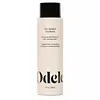What's inside
What's inside
 Key Ingredients
Key Ingredients

No key ingredients
 Benefits
Benefits

 Concerns
Concerns

 Ingredients Side-by-side
Ingredients Side-by-side

Water
Skin ConditioningDistearyldimonium Chloride
Stearyl Alcohol
EmollientStearamidopropyl Dimethylamine Lactate
Cetyl Alcohol
EmollientCocos Nucifera Oil
MaskingGlycerin
HumectantPhenoxyethanol
PreservativeParfum
MaskingGlycine Soja Oil
EmollientPolysorbate 60
EmulsifyingSteareth-20
CleansingMethylparaben
PreservativeSodium Chloride
MaskingPEG-150 Stearate
Hydrolyzed Collagen
EmollientPropylparaben
PreservativeLanolin
EmollientOlea Europaea Fruit Oil
MaskingCI 19140
Cosmetic ColorantBenzyl Benzoate
AntimicrobialAlpha-Isomethyl Ionone
PerfumingHexyl Cinnamal
PerfumingLinalool
PerfumingLimonene
PerfumingCitronellol
PerfumingGeraniol
PerfumingBenzyl Salicylate
PerfumingWater, Distearyldimonium Chloride, Stearyl Alcohol, Stearamidopropyl Dimethylamine Lactate, Cetyl Alcohol, Cocos Nucifera Oil, Glycerin, Phenoxyethanol, Parfum, Glycine Soja Oil, Polysorbate 60, Steareth-20, Methylparaben, Sodium Chloride, PEG-150 Stearate, Hydrolyzed Collagen, Propylparaben, Lanolin, Olea Europaea Fruit Oil, CI 19140, Benzyl Benzoate, Alpha-Isomethyl Ionone, Hexyl Cinnamal, Linalool, Limonene, Citronellol, Geraniol, Benzyl Salicylate
Water
Skin ConditioningCetearyl Alcohol
EmollientStearyl Alcohol
EmollientGlycerin
HumectantAmodimethicone
Behentrimonium Chloride
PreservativeAvena Sativa Kernel Extract
AbrasiveAmaranthus Caudatus Seed Extract
Skin ConditioningHydrolyzed Rice Protein
Skin ConditioningHydroxyethylcellulose
Emulsion StabilisingTetrasodium Glutamate Diacetate
Diheptyl Succinate
EmollientCapryloyl Glycerin/Sebacic Acid Copolymer
Skin ConditioningCetrimonium Chloride
AntimicrobialLinoleamidopropyl Pg-Dimonium Chloride Phosphate Dimethicone
Isopropyl Alcohol
SolventTrideceth-3
EmulsifyingTrideceth-15
EmulsifyingAcetic Acid
BufferingEthylhexylglycerin
Skin ConditioningPhenoxyethanol
PreservativeSodium Hydroxide
BufferingCitric Acid
BufferingWater, Cetearyl Alcohol, Stearyl Alcohol, Glycerin, Amodimethicone, Behentrimonium Chloride, Avena Sativa Kernel Extract, Amaranthus Caudatus Seed Extract, Hydrolyzed Rice Protein, Hydroxyethylcellulose, Tetrasodium Glutamate Diacetate, Diheptyl Succinate, Capryloyl Glycerin/Sebacic Acid Copolymer, Cetrimonium Chloride, Linoleamidopropyl Pg-Dimonium Chloride Phosphate Dimethicone, Isopropyl Alcohol, Trideceth-3, Trideceth-15, Acetic Acid, Ethylhexylglycerin, Phenoxyethanol, Sodium Hydroxide, Citric Acid
Ingredients Explained
These ingredients are found in both products.
Ingredients higher up in an ingredient list are typically present in a larger amount.
Glycerin is already naturally found in your skin. It helps moisturize and protect your skin.
A study from 2016 found glycerin to be more effective as a humectant than AHAs and hyaluronic acid.
As a humectant, it helps the skin stay hydrated by pulling moisture to your skin. The low molecular weight of glycerin allows it to pull moisture into the deeper layers of your skin.
Hydrated skin improves your skin barrier; Your skin barrier helps protect against irritants and bacteria.
Glycerin has also been found to have antimicrobial and antiviral properties. Due to these properties, glycerin is often used in wound and burn treatments.
In cosmetics, glycerin is usually derived from plants such as soybean or palm. However, it can also be sourced from animals, such as tallow or animal fat.
This ingredient is organic, colorless, odorless, and non-toxic.
Glycerin is the name for this ingredient in American English. British English uses Glycerol/Glycerine.
Learn more about GlycerinPhenoxyethanol is a preservative that has germicide, antimicrobial, and aromatic properties. Studies show that phenoxyethanol can prevent microbial growth. By itself, it has a scent that is similar to that of a rose.
It's often used in formulations along with Caprylyl Glycol to preserve the shelf life of products.
Stearyl Alcohol is a type of fatty alcohol from stearic acid. It is a white, waxy compound used to emulsify ingredients.
Fatty Alcohols are most often used as an emollient or to thicken a product. Emollients help soothe and hydrate the skin by trapping moisture.
They are usually derived from natural fats and oils and therefore do not have the same drying or irritating effect as solvent alcohols. FDA allows products labeled "alcohol-free" to have fatty alcohols.
Learn more about Stearyl AlcoholWater. It's the most common cosmetic ingredient of all. You'll usually see it at the top of ingredient lists, meaning that it makes up the largest part of the product.
So why is it so popular? Water most often acts as a solvent - this means that it helps dissolve other ingredients into the formulation.
You'll also recognize water as that liquid we all need to stay alive. If you see this, drink a glass of water. Stay hydrated!
Learn more about Water